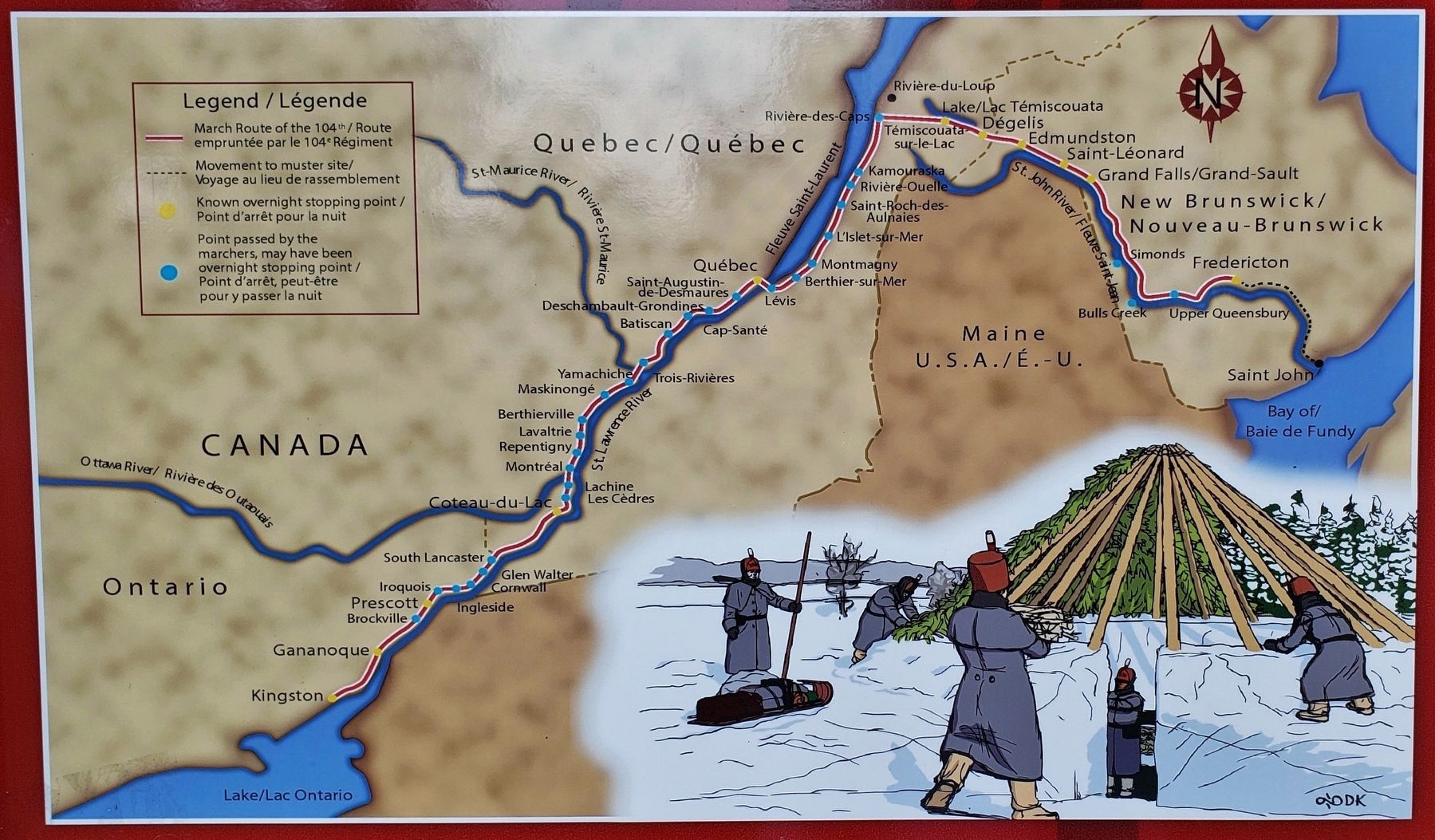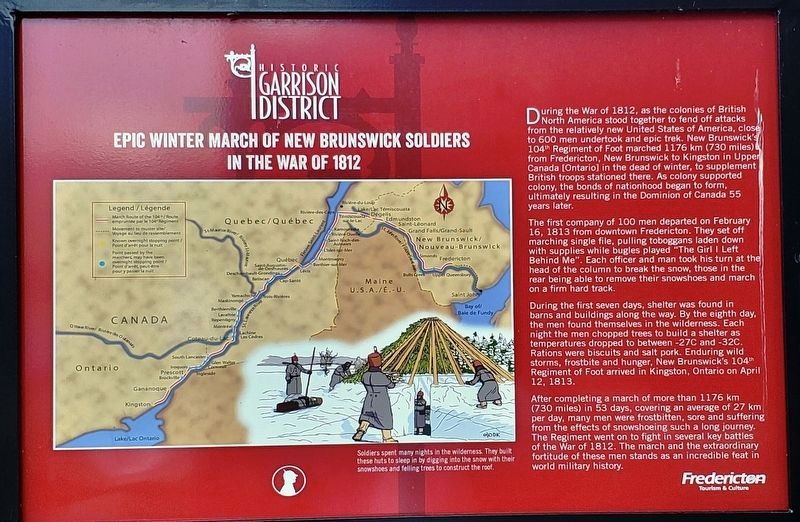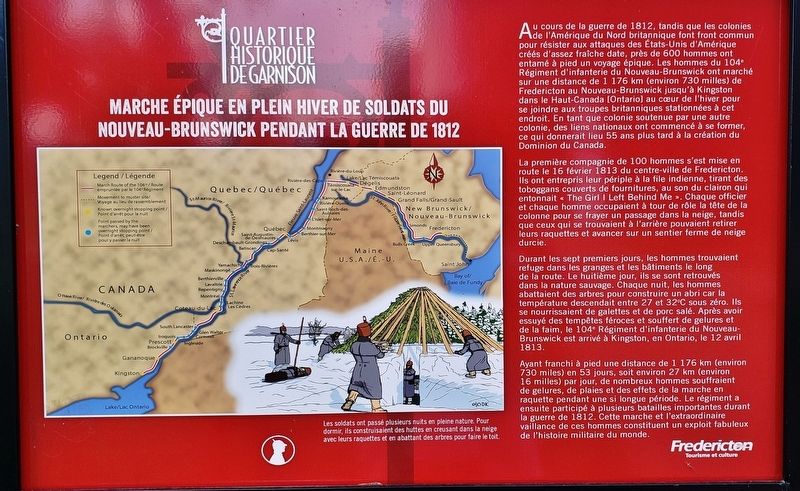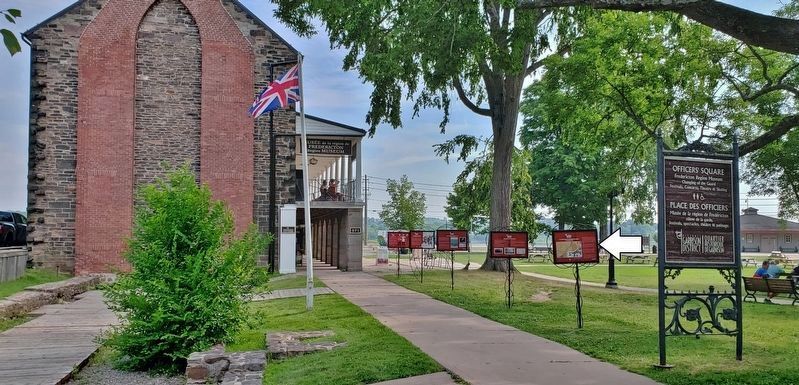Fredericton in York County, New Brunswick — The Atlantic Provinces (North America)
Epic Winter March of New Brunswick Soldiers in the War of 1812
Marche épique en plein hiver de soldats du Nouveau-Brunswick pendant la guerre de 1812
Inscription.
During the War of 1812, as the colonies of British North America stood together to fend off attacks from the relatively new United States of America, close to 600 men undertook an epic trek. New Brunswick's 104th Regiment of Foot marched 1176 km (730 miles) from Fredericton, New Brunswick to Kingston in Upper Canada [Ontario] in the dead of winter, to supplement British troops stationed there. As colony supported colony, the bonds of nationhood began to form, ultimately resulting in the Dominion of Canada 55 years later.
The first company of 100 men departed on February 16, 1813 from downtown Fredericton. They set off marching single file, pulling toboggans laden down with supplies while bugles played "The Girl I Left Behind Me". Each officer and man took his turn at the head of the column to break the snow, those in the rear being able to remove their snowshoes and march on a firm hard track.
During the first seven days, shelter was found in barns and buildings along the way. By the eighth day, the men found themselves in the wilderness. Each night the men chopped trees to build a shelter as temperatures dropped to between -27C and -32C. Rations were biscuits and salt pork. Enduring wild storms, frostbite and hunger, New Brunswick's 104th Regiment of Foot arrived in Kingston, Ontario on April 12, 1813.
After completing a march of more than 1176 km (730 miles) in 53 days, covering an average of 27 km per day, many men were frostbitten, sore and suffering from the effects of snowshoeing such a long journey. The Regiment went on to fight in several key battles of the War of 1812. The march and the extraordinary fortitude of these men stands as an incredible feat in world military history.
Au cours de la guerre de 1812, tandis que les colonies de l'Amérique du Nord britannique font front commun pour résister aux attaques des États-Unis d'Amérique créés d'assez fraîche date, près de 600 hommes ont entamé à pied un voyage épique. Les hommes du 104e Régiment d'infanterie du Nouveau-Brunswick ont marché sur une distance de 1 176 km (environ 730 milles) de Fredericton au Nouveau-Brunswick jusqu'à Kingston dans le Haut-Canada [Ontario] au cœur de l'hiver pour se joindre aux troupes britanniques stationnées à cet endroit. En tant que colonie soutenue par une autre colonie, des liens nationaux ont commencé à se former, ce qui donnerait lieu 55 ans plus tard à la création du Dominion du Canada.
La première compagnie de 100 hommes s'est mise
en route le 16 février 1813 du centre-ville de Fredericton. Ils ont entrepris leur périple à la file indienne, tirant des toboggans couverts de fournitures, au son du clairon qui entonnait « The Girl I Left Behind Me ». Chaque officier et chaque homme occupaient à tour de rôle la tête de la colonne pour se frayer un passage dans la neige, tandis que ceux qui se trouvaient à l'arrière pouvaient retirer leurs raquettes et avancer sur un sentier ferme de neige durcie.
Durant les sept premiers jours, les hommes trouvaient refuge dans les granges et les bâtiments le long de la route. Le huitième jour, ils se sont retrouvés dans la nature sauvage. Chaque nuit, les hommes abattaient des arbres pour construire un abri car la température descendait entre 27 et 32°C sous zéro. Ils se nourrissaient de galettes et de porc salé. Après avoir essuyé des tempêtes féroces et souffert de gelures et de la faim, le 104e Régiment d'infanterie du Nouveau-Brunswick est arrivé à Kingston, en Ontario, le 12 avril 1813.
Ayant franchi à pied une distance de 1 176 km (environ 730 miles) en 53 jours, soit environ 27 km (environ 16 milles) par jour, de nombreux hommes souffraient de gelures, de plaies et des effets de la marche en raquette pendant une si longue période. Le régiment a ensuite participé à plusieurs batailles importantes durant la guerre de 1812. Cette marche et l'extraordinaire

3. Marker detail: Map
Soldiers spent many nights in the wilderness. They built these huts to sleep in by digging into the snow with their snowshoes and felling trees to construct the roof.
• • •
Les soldats ont passé plusieurs nuits en pleine nature. Pour dormir, ils construisaient des huttes en creusant dans la neige avec leurs raquettes et en abattant des arbres pour faire le toit.
• • •
Les soldats ont passé plusieurs nuits en pleine nature. Pour dormir, ils construisaient des huttes en creusant dans la neige avec leurs raquettes et en abattant des arbres pour faire le toit.
Erected by Fredericton Tourism and Culture/Tourisme et culture de Fredericton.
Topics. This historical marker is listed in these topic lists: Colonial Era • War of 1812. A significant historical year for this entry is 1813.
Location. 45° 57.706′ N, 66° 38.372′ W. Marker is in Fredericton, New Brunswick, in York County. Marker can be reached from Queen Street (New Brunswick Route 102) west of Sainte Anne's Point Drive, on the right when traveling west. Marker is located at the Officers' Square Provincial Heritage site, on the south side of the Fredericton Region Museum. Touch for map. Marker is at or near this postal address: 571 Queen Street, Fredericton NB E3B 5C8, Canada. Touch for directions.
Other nearby markers. At least 8 other markers are within walking distance of this marker. Birthplace of the Canadian Army (here, next to this marker); Juliana Horatia (Gatty) Ewing (here, next to this marker); Charles Rainsford's Brave Rescue (here, next to this marker); Anatomy of the Guard (a few steps from this marker); New Brunswick's 104th Regiment of Foot (within shouting distance of this marker); The Right Honourable William Maxwell Lord Beaverbrook (within shouting distance of this marker); Fredericton Military Compound / Le Complexe Militaire de Frédéricton
(about 120 meters away, measured in a direct line); The 104th Regiment / Le 104e Régiment (about 150 meters away). Touch for a list and map of all markers in Fredericton.
More about this marker. South side of marker in English; north side of marker in French • Côté sud du marqueur en anglais; côté nord du marqueur en français
Related markers. Click here for a list of markers that are related to this marker. New Brunswick's 104th Regiment of Foot
Credits. This page was last revised on July 8, 2020. It was originally submitted on July 5, 2020, by Cosmos Mariner of Cape Canaveral, Florida. This page has been viewed 307 times since then and 20 times this year. Photos: 1, 2, 3, 4. submitted on July 6, 2020, by Cosmos Mariner of Cape Canaveral, Florida.


